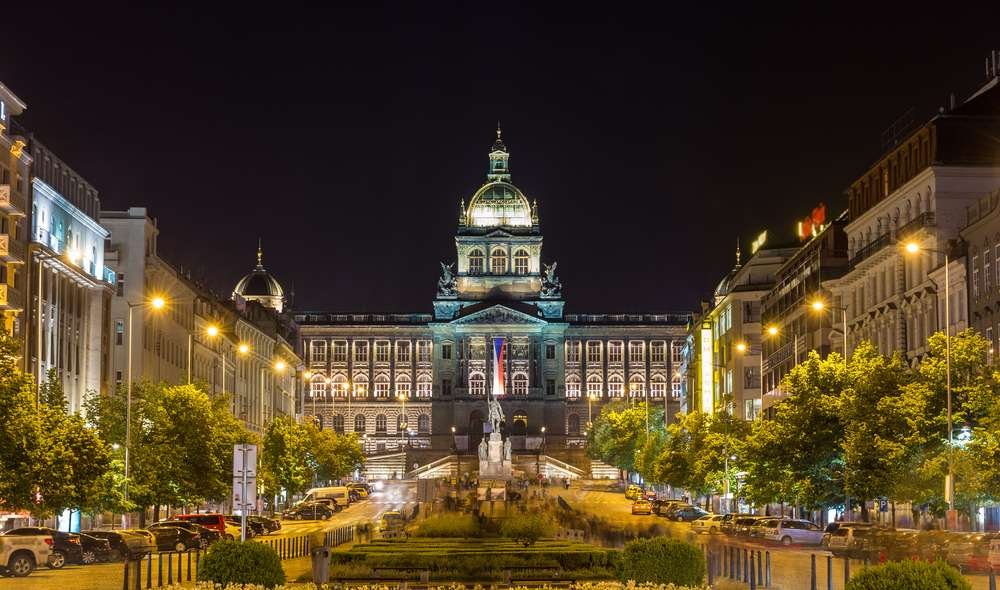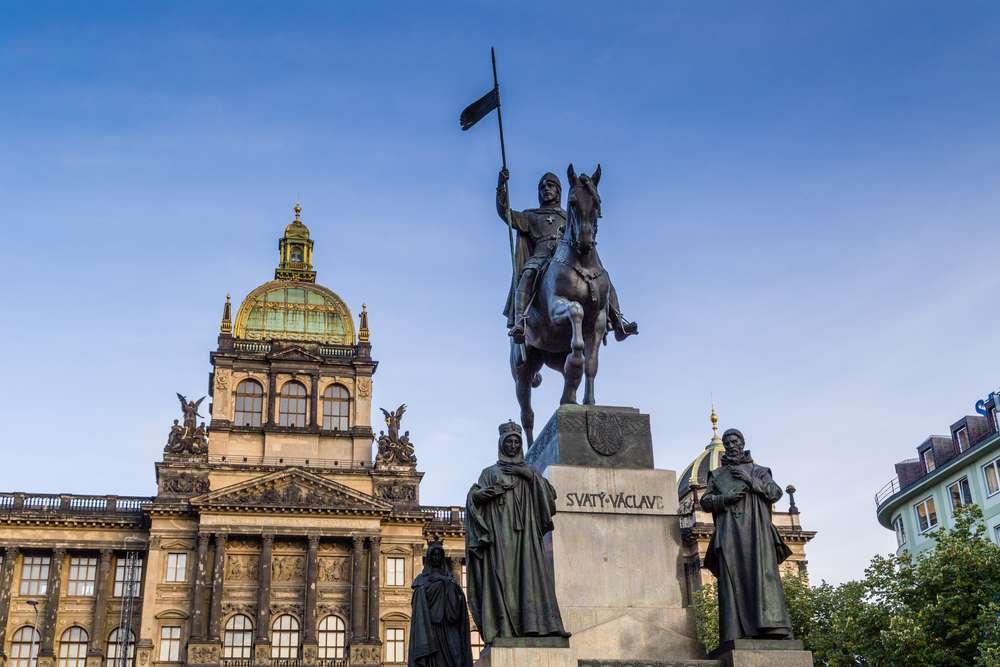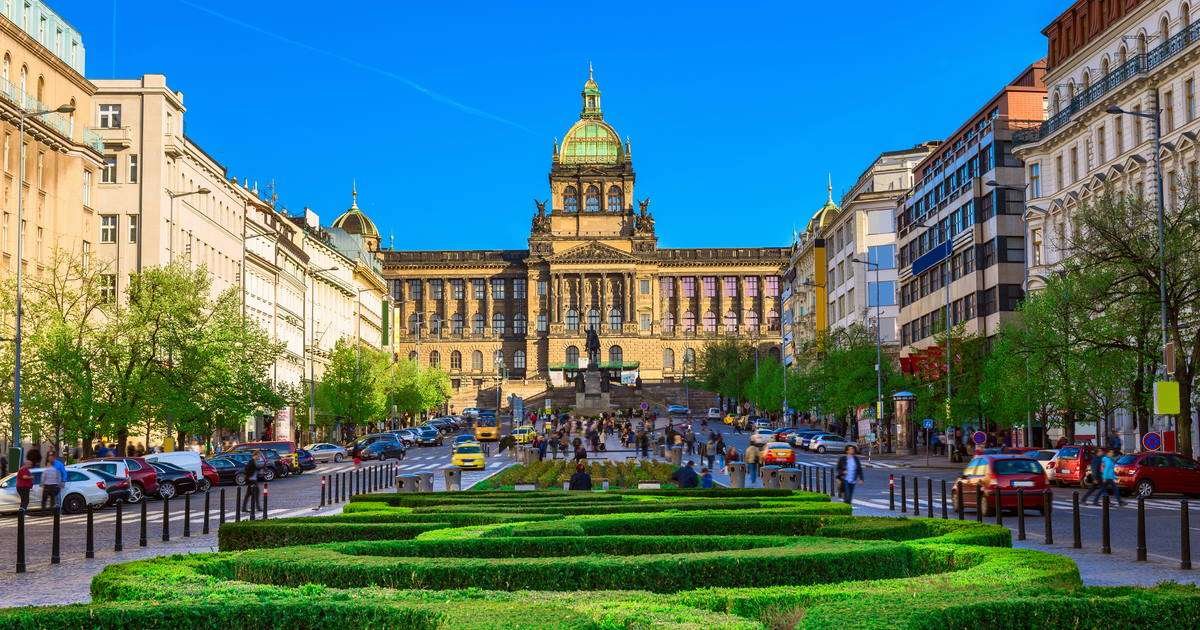The National Museum stands at the top of Wenceslas Square.
It is the oldest and largest museum in the Czech Republic. It consists of an Old Building, founded in 1818, and the opposite New Building, which is a significant architectural contrast.
In addition, the museum has numerous exhibition buildings in Prague.
Here we collected all the important information about the National Museum, this includes the entrance fee, its history, and address. The ticket is valid as an entrance ticket to both buildings of the museum.
What Can I Do at the National Museum?

The Old Building
The historic building of the National Museum at the top of Wenceslas Square was declared a national cultural monument in 1962. In addition to temporary exhibitions, it houses numerous permanent exhibitions divided by theme. The following are particularly noteworthy.
- Nature: The paleontological collection displays, among other things, one a huge dinosaur bone, said to be the only one ever excavated in the Czech Republic.
- Wonders of Evolution: This exhibition focuses on the history of evolution. It aims to trace the development of prehistoric life up to mammals.
- History of the 20th Century: The intertwining of politics, economics, and everyday history from the beginning of the 1st Republic to the 21st century is the theme of this multimedia collection.
- People: This exhibit covers the history of human development, from Neanderthals to ancient Mediterranean cultures.
- Treasure and Coin Cabinet: Jewels, precious stones, and a numismatic collection are on display here.
Connecting Corridor
The connecting corridor between the historic building and the new building houses a multimedia exhibition on the history of Wenceslas Square between 1918 and 2018.
New Building
There are also numerous permanent exhibitions in the new part of the National Museum, including the following.
- Children's Museum: Themes of the exhibition include the Paleocene sea, mammoth hunting, the Middle Ages, and the discovery of natural laws.
- History: The historical development of Bohemia from the 9th century to the 1st World War is the focus of this exhibition.
Cultural and Educational Programs
The National Museum offers a number of cultural and educational programs. For more details click here, you will be redirected to the official website of the museum.
Jan Palach and Jan Zajíc Monument
On January 16, 1969, twenty-year-old student Jan Palach doused himself with gasoline, lit a match and walked as a human torch from the steps of the National Museum to Wenceslas Square. He wanted to protest against the suppression of the Prague Spring and the dictates of the Soviet Union. Four days later he succumbed to his burns.
On February 25, 1969, Jan Zajíc, who is therefore also called "Torch No.2", did the same, he died instantly.
On the ground in front of the National Museum there are memorials to the two students.
Admission, Tickets, and Guided Tours

- Tickets: Usually there are long lines in front of the entrance, where you have to wait at least 20-30 minutes to get a ticket. Therefore, we recommend buying tickets online here.
- Guided Tours: The National Museum is open all year round. For more details about the entrance fees as well as exact details about guided tours, please click here, you will be redirected to the official website of the museum.
- Admission: The ticket is valid for both buildings of the National Museum, the old part and the new part.
How Do I Get to the National Museum?
The National Museum is located about a 15-minute walk from the Old Town Square and can be easily reached by metro line A, green line and by metro line C, red line, at the Muzeum stop.
History of the National Museum

The National Museum was founded in 1818 as "The Patriotic Museum in Bohemia" by the so-called Gala Proclamation of the national nobility, led by the mineralogist and paleontologist Kaspar Count von Sternberg. In 1934 it became the property of the country and in 1949 it was transferred to state ownership. Initially, the collections were primarily natural science oriented.
Today, the main building on Wenceslas Square houses, among other things, an archaeological-historical, a mineralogical, a zoological, and an anthropological department. It was renovated for 7 years and reopened in October 2018.
The building stands out for its monumentality. For example, the more than 100-meter-long front facade is accessible via a ramp, gilded marble slabs with names of important Czech personalities are attached to the facade, the entrance hall is decorated by bronze statues, and famous places in Czech history are depicted on the walls. The interior decoration is mostly by artists who also decorated the National Theater.
The New Part of the National Museum was built in 1885-1891 in the Neo-Renaissance style. It originally housed the Prague Stock Exchange, and from 1946 it was the seat for the Parliament until the dissolution of the Czechoslovak Republic in 1992. Since 2015, it has been part of the National Museum and, in addition to some permanent exhibitions, houses numerous special exhibitions that change frequently.
In the foyer is a café and a museum store.
Both buildings were connected by an underground corridor with a unique multimedia exhibition.
The National Museum is the Czech Republic's leading museum of cultural and natural history and, in addition to the main building on Wenceslas Square, has various exhibition rooms spread throughout Prague.
Contact
- Address: Václavské nám. 68, 110 00 Nové Město, Prague
- Public Transport: Metro line A, green line and metro line C, red line, Muzeum Stop
- Opening Hours: You can find the exact opening hours here.

